Scrawled Filefish
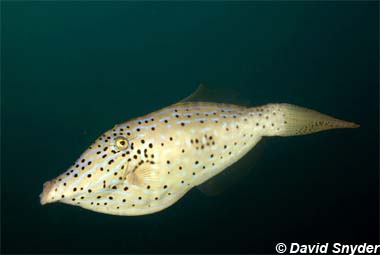
Aluterus scriptus
This lagoon or reef fish has an elongated oval, flat body, with a small, upturned mouth and weak fins. It is a plain gray or brown color with bright, irregular blue lines and black spots. When threatened, it hides in a crevice and extends the large spine on its head and the smaller one under its belly to wedge itself into the small space. It’s a popular fish with divers and aquariums because it is slow moving and attractive.
Order – Tetraodontiformes
Family – Monacanthidae
Genus – Aluterus
Species – scriptus
Common Names
English language common names are scrawled filefish, broom-tail file, broomtail filefish, filefish, scrawled leatherjacket, scrawled tilefish, scribbled filefish, scribbled fish, scribbled leather jacket, scribbled leatherjacket, scribbled leatherjacket filefish, scrolled filefish, and tobaccofish. Other common names are alutera pisana (Polish), baliste écriture (French), barat-barat (Malay), bekrapte leerbaadjie (Afrikaans), bourse écriture (French), bourse graffiti (French), bourse loulou (French), bourse robe-de-cuir (French), cabra (Portuguese), cabrinha (Portuguese), cachua (Spanish), cachúa lija azul (Spanish), cangulo de areia (Portuguese), cangulo-pavão (Portuguese), cangulo-velho (Portuguese), cangulovelho (Portuguese), chien katounou (French), falala (Samoan), fathi-rondu (Mahl), Großer Feilenfisch (German), langhalet filfisk (Danish), lija (Spanish), lija trompa (Spanish), lioma (Carolinian), loulu (Hawaiian), paal (Carolinian), pakol (waray-waray), panitan (waray-waray), papae (Tongan), paratet (Carolinian), pariyen (Carolinian), pareva (Tahitian), peixe-porco-galhudo (Portuguese), pesce lima (Italian), pez lija puntiazul (Spanish), phwa (Kumak), porgo rabiscado (Portuguese), puerco de altura (Spanish), puerco de lijatrompa (Spanish), ravi (Fijian), sagok-sok (Surigaonon), sagoksok (Cebuano), sagugsok (Davaweyno), samarang (Maranao/Samal/Tao Sug), sôshihagi (Japanese), sulay bagyo (Visayan), sulyo bagyo (Visayan), tato kambing (Malay), te kabanei (Kiribati), tiwarik ((Tagalog), ume-aleva (Samoan), and unicornios (Spanish).
Importance to Humans
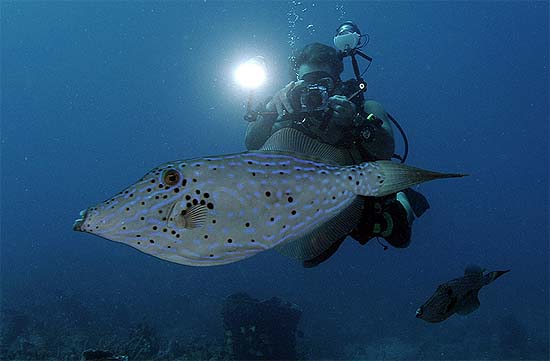
In addition to being considered a gamefish in some locations, this species is also often collected for the aquarium trade. If the flesh of this fish is eaten, caution should be taken as there have been reported incidences of ciguatera poisoning.
Conservation
The scrawled filefish is not listed as endangered or vulnerable with the World Conservation Union (IUCN). The IUCN is a global union of states, governmental agencies, and non-governmental organizations in a partnership that assesses the conservation status of species.
> Check the status of the scrawled filefish at the IUCN website.
Geographical Distribution

The scrawled filefish is circumtropical in distribution, ranging in the Western Atlantic from Nova Scotia, Canada and the northern Gulf of Mexico south to Brazil. In the Eastern Atlantic, it is found at St. Paul’s Rocks, Cape Verde, and the Ascension Islands; São Tomé Island, and South Africa. This species is also found in the Pacific Ocean from southern Japan to the southern Great Barrier Reef, New Caledonia, and Easter Island all in the western Pacific while in the eastern Pacific, this fish resides from the Gulf of California south to Colombia.
Habitat
Associated with lagoons and seaward reefs, the scrawled filefish may be found in subtropical waters at depths from 10-394 feet (3-120 m) but more typically seen at 10-66 feet (3-20 m). It is also sometimes observed swimming under floating objects with juveniles traveling with weed rafts in the open ocean until reaching a large size. Juvenile scrawled filefish often swim in a vertical, head-down position when associated with drifting vegetation to avoid being detected by potential predators.
In addition to camouflage, filefish use spines for protection from predation. When threatened, the filefish will dive quickly into a crevice in the reef, wedging itself into the shelter by erecting the dorsal spine on its head. This large spine is locked into place by the smaller spine located behind it while another spine located on the belly extends to further securely wedging the fish in the crevice. This behavior is also used when the filefish rests on the reef at night.
Biology
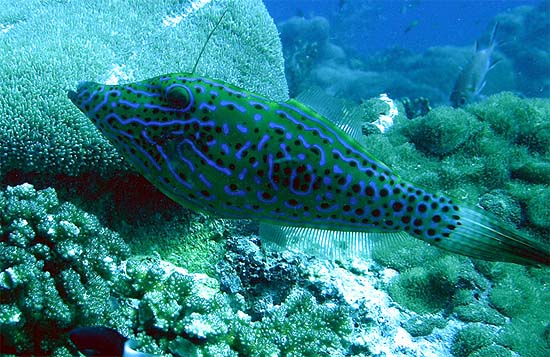
Distinctive Features
It is an elongate, strongly compressed filefish. The upturned mouth is small and opens above center line and the snout is concave. The openings of the gills are oblique and the pelvic fin is absent. The caudal fin is long and rounded with a back edge that is often ragged.
Coloration
Adult scrawled filefish are olive brown to gray in color with irregular blue spots and short lines as well as small black spots while the juveniles may be yellowish brown with dark spots.
Dentition
The teeth of the scrawled filefish are moderately strong with six in the outer row along the upper jaw and six or less in the outer row along the bottom jaw.
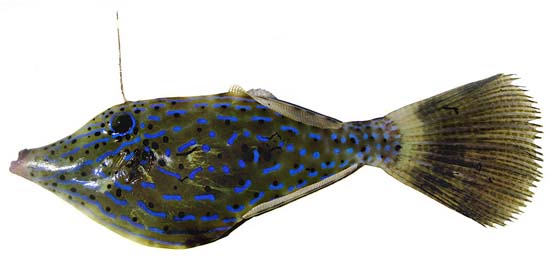
Size, Age, and Growth
Although this species commonly reaches a total length of 22 inches (55 cm), the maximum reported length of the scrawled filefish is 43 inches (110 cm) TL. In addition, the maximum documented weight of this fish is 5.5 pounds (2.5 kg).
Food Habits
The scrawled filefish feeds on algae, seagrass, hydrozoans, gorgonians, colonial anemones, and tunicates.
Reproduction
Filefish breed in groups consisting of one male and two to five females. The females lay demersal eggs in safe areas such as a depression in the sand, then the male comes along and fertilizes them. The male or female will guard these fertilized eggs from predators and will attack any intruders that approach too closely. Upon hatching, the female will take care of the young fish.
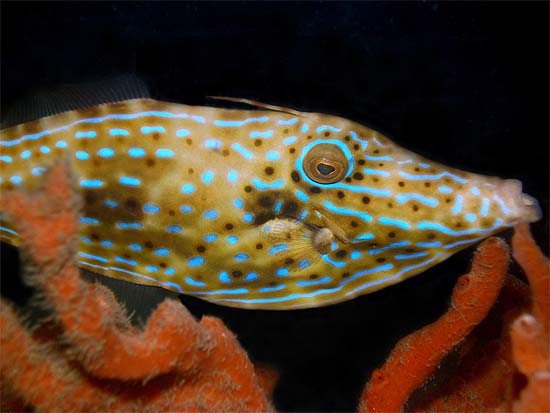
Predators
Larger fish are potential predators of the scrawled filefish including dolphinfish (Coryphaena hippurus) and bluefin tuna (Thunnus thynnus).Parasites
Scrawled filefish are known to be parasitized by the copepods Caligus haemulonis and C. ballistae as well as the monogenean ectoparasite Neobenedia melleni.
Taxonomy
This species was described as Aluterus scriptus by Osbeck in 1765. Synonyms appearing in past scientific literature referring to this species include Balistes laevis Bloch 1795, Balistes liturosus Shaw 1804, Balistes ornatus Proce 1822, Aluteres pareva Lesson 1831, Aluteres personatus Lesson 1831, Aluterus venosus Hollard 1855, Aluterus renosus Hollard 1855, Alutera picturata Poey 1863, and Alutera armata Garman 1903.
Prepared by: Cathleen Bester